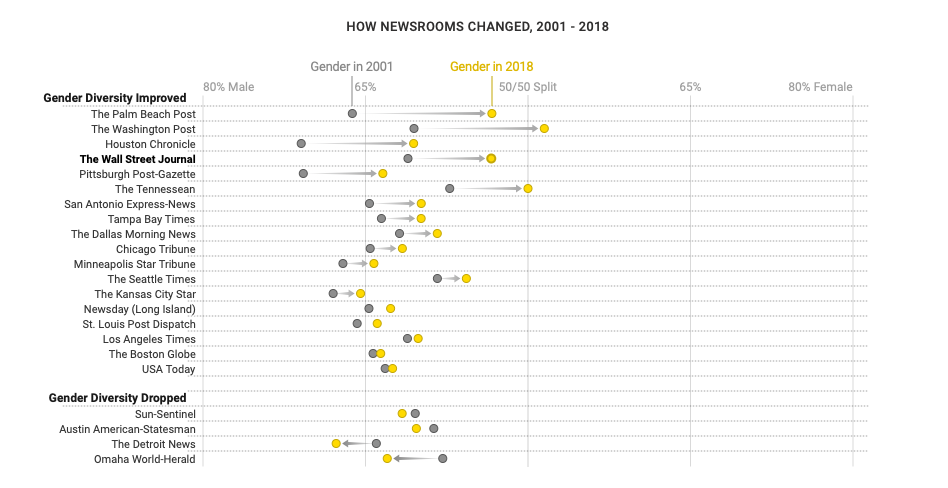In college, women fill journalism classes, while men remain a minority. But a few years later, when those students enter the workforce, the situation shifts. Men dominate newsrooms, outnumbering women on almost all occasions. Although the gap has decreased in recent years, women still lag in journalism—they represent only 41.7% of newsroom employees, according to the latest report by the Women Media Center.
Like other industries, journalism has always been predominantly male. But, while in other sectors the number of women employed has steadily increased, in journalism the trend has been slower. The media industry is a little over one-third female, whereas women comprise over two-thirds of the students graduating from communications and journalism—it has been so since the late 80s. Most women enter newsrooms straight out of college, but twenty years later, only a third of the newsroom is female. So where do these women go? And why are they turned away by their chosen profession?

The reasons are multiple. On the one hand, low wages, strange hours, and 24/7 availability turn women away as, generally, they still carry the majority of the childrearing. On the other, the lack of female leadership also deters female journalists from escalating the editorial ladder. Male editors tend to promote men. When women don’t see promotion opportunities, they change jobs, which means fewer women are available for editor positions later on. Finally, the gender disparity also reflects on the beats. Men usually cover hard news, while women write about softer issues with less breaking news and more flexible schedules. The problem is that covering harder news (business, politics, foreign policy) sets journalists on the path to senior leadership. Once again, women are left behind. After a while, many abandon the sector and take communications jobs, where there are better incentives.
However, the industry is slowly changing. The Newspaper Diversity Survey from the American Society of News Editors revealed that 32% of newsrooms gained gender diversity since 2001. Among the national outlets, The Washington Post is leading the pack—52% of the newsroom and 50% of the leadership is now female; whereas in 2001 the split was closer to 57/43, favoring men. The Wall Street Journal has also hired more significant numbers of women—47% of newsroom employees and 44% of the leadership are females. The general female employment trend and the disruption of digital news outlets in the early 2000s, with flatter hierarchies and younger leaders, has furthered gender diversity. Also, millennials in the US—an essential part of the workforce—have different expectations than baby boomers. They value diversity, marry later, and don’t stay in one workplace for ten years.
Not all is good news. There’s also been a decline in gender diversity in 21% of the newsrooms surveyed, especially in local newspapers. For example, The Detroit News is now 32% female—27% of the leadership,—whereas in 2001 the numbers were closer to 60/40 favoring men. As many local outlets close and more shrink their staff, women are the first ones to leave.
Men still dominate journalism jobs, editors are still predominantly male, but the tide is turning or at least slowly shifting. Women are staying in newsrooms, promoting other women, quoting more female sources on news pieces, and making sure that journalism is no longer male-only.



already in my country woman law in few , and men in jornal magezine work almost
Esperamos que poco a poco la mujer vaya ocupando el lugar que se merece
Interesante artículo. Creo que desde su publicación que fue en el 2019 todo ha evolucionado a mejor y el papel de la mujer se está equilibrando. Esperemos que esta mejoría continúe y el tema del género sea pronto algo del pasado.
Aunque nos cueste reconocerlo a los hombres, las mujeres son mucho más inteligentes y capaces de todo que nosotros y es cuestión de tiempo que en oficios como el periodismo acaben ocupando más puestos que los hombres, ojalá sea así y que la igualdad se instale por fin en todo el mundo no sólo en ciertos paises de Europa.